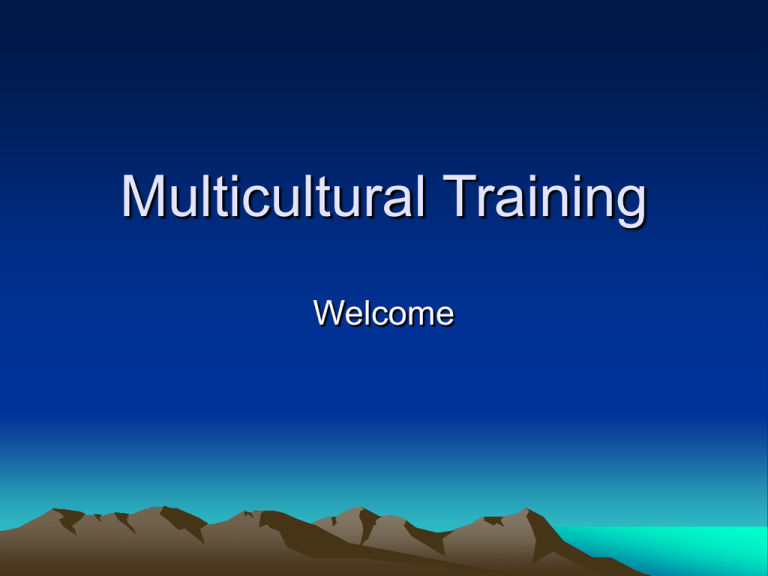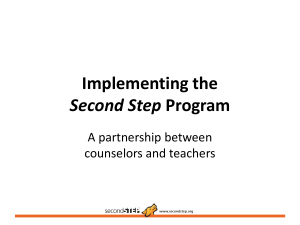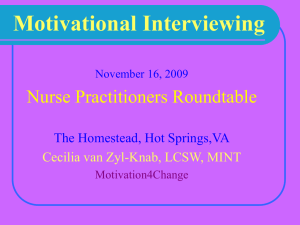Multicultural Training
advertisement

Multicultural Training Welcome Logistics • • • • • CEU credits Workshop Schedule Cell phones Bathroom breaks Participant packets Getting Acquainted 1. Name 2. Profession/Job role 3. Experience working with multicultural populations 4. Share something that is important to you about your own cultural, ethnic, and/or racial background Workshop Goals • Increased awareness of own assumptions, values, and biases • Greater knowledge of the world view of the culturally diverse or different client • New skill with appropriate counselor interventions, strategies and techniques • A personal action plan for applying what you have learned Guided by: • Model of Multicultural Competencies (Sue, Arrendondo, & McDavis, 1992) focuses on three main areas of development: – BELIEFS – KNOWLEDGE – SKILLS Awareness Counselor’s Awareness of Own Assumptions, Values and Bias Understanding the Worldview of the Culturally Diverse Client 1. 1. 2. 3. 4. Culturally selfaware Aware of biases’ influence Realize personal limitations Comfortable with client’s racial, ethnic, cultural, and belief differences 2. Developing Appropriate Counselor Interventions, Strategies, and Techniques Contrast own 1. beliefs with client’s in nonjudgmental fashion 2. Aware of stereotypes and preconceived notions about the 3. different ways of racial and ethnic minority groups Respect client’s religious or spiritual beliefs/values Respect indigenous helping practices and networks Value bilingualism Knowledge Counselor’s Awareness of Own Assumptions, Values and Bias 1. 2. 3. Understanding the Worldview of the Culturally Diverse Client How counselor 1. heritage affects definition of normality/abnormality How oppression, racism, discrimination, and stereotypes affect on counselor work, allowing counselor to 2. acknowledge individual racism How counselor’s social impact and 3. communication style differences affect on clients and how to anticipate their impact Have information of particular group one is working with (e.g., life experiences, cultural heritage, and historical background of culturally different client) Culture’s affect on personality, choices, and preferences for counseling approaches Sociopolitical influences that impinge on minority life (e.g., poverty, racism, powerlessness) Developing Appropriate Counselor Interventions, Strategies, and Techniques 1. 2. 3. 4. 5. How generic counseling skills may clash with cultural systems How institutional barriers hinder minority usage of mental health services Potential bias in assessment instruments Minority family structure, hierarchies, values, and beliefs Discriminatory practices in society Skills Counselor’s Awareness of Own Assumptions, Values and Bias Understanding the Worldview of the Culturally Diverse Client Developing Appropriate Counselor Interventions, Strategies, and Techniques 1. 1. 1. 2. Seek our educational, consultative, and training experiences to enrich understanding of culturally different populations, recognizing the limitations of your competencies Understand self as a racial and cultural being and actively seek a nonracist identity 2. Understand relevant research and latest findings on crosscultural mental health issues, disorders, and service Become actively involved with minorities outside the counseling setting so one’s perspective is more than an academic or helping exercise 2. 3. 4. 5. 6. 7. Able to engage in a variety of verbal and nonverbal helping responses Able to exercise institutional intervention skills on behalf of client Consult with traditional healers or religious leaders Interact in client’s language Aware of cultural limitations Is assessment and testing instruments Seek to eliminate biases, prejudice, and discriminatory practices Educate clients in goals, expectations rights, and counselor orientation Difficult/Different Clients • It was so much easier to blame it on Them. It was bleakly depressing to think that They were Us. If it was Them, then nothing was anyone's fault. If it was us, what did that make Me? After all, I'm one of Us. I must be. I've certainly never thought of myself as one of Them. No one ever thinks of themselves as one of Them. We're always one of Us. It's Them that do the bad things. Ground Rules • • Be Respectful of Others Disagree Agreeably – Ouch – Oops • • Respect Confidentiality Speak One at a Time Facilitator’s Expectations • Expect to experience a range of thoughts and feelings throughout the day • Expect to start and finish at your own pace • Expect to leave without all the answers • Expect to get out of the workshop what you are willing to put into the workshop • Expect to take risks • Expect to be treated with respect RACE: GROUPINGS BASED ON PHYSICAL TRAITS BY WHICH PEOPLE CAN BE DISTINGUISHED Ethnicity Referring to group membership often, but not necessarily, specifically linked by race, nationality, religion and/or language. People belonging to the same ethnic group share a common cultural heritage and/or derivation, distinguished by such characteristics as: o o o o o Geographic origins Family patterns Language Values Cultural norms o o o o History Music Gender roles Dietary patterns Culture Shared values, traditions, norms, customs, religion, arts, history, folklore, language and/or institutions of a specific group of people. Privilege • Right or immunity granted as a peculiar benefit, advantage, or favor. • Such a right or immunity attached specifically to a position or an office. White Privilege I have come to see white privilege as an invisible package of unearned assets which I can count on cashing in each day, but about which I was “meant” to remain oblivious. White privilege is like an invisible weightless knapsack of special provisions, maps, passports, codebooks, visas, clothes, tools, and blank checks. (Peggy McIntosh) Prejudice • Process of pre-judging something. • Prejudice generally refers to existing biases towards members of a group, which are often based on stereotypes. Racism • Racism is defined as the belief that race is the primary determinant of human traits and capacities and that racial differences produce an inherent superiority of a particular race. – Overt – Covert Cultural Encapsulation • Assumptions that are based solely on our own world views and do not take into account the context of others • Universal notions of “healthy and normal” Barriers to Cultural Competence Language Barriers Verbal communication Non verbal communication o Racial/Ethnic Identity Barriers Ethnic Minority Identity Models White Identity Models Non-verbal Communication • Proxemics- personal and interpersonal space • Kinesics- body movements, posture, gestures, eye contact • Paralanguage- other vocal cues (rate of speech, inflections) • High/Low Context Communication – High: reliance on non-verbal cues – Low: reliance on verbal message Racial/Cultural Identity Model (Sue and Sue, 1990) • • • • • Conformity Dissonance Resistance and Immersion Introspection Integrative Awareness White Identity Model (Sue and Sue, 1990) • • • • • Conformity Dissonance Resistance and Immersion Introspective Phase Integrative Awareness The Federal Five •Between Group Differences •Within Group Differences •“Dynamic Sizing”—Be cautious of generalizations. Cultural Dimensions Federal Five African American American Indian Asian American/ Pacific Islander Hispanic White Americans Religious and/or Spiritual Values Family Roles Communication Patterns Gender Roles Cultural Norms Historical Context Views on Mental health or drug/ETOH African American • • • • • • • Religious Influences- Church = Community Family Roles- Extended family Communication Patterns- Assertive, Affect, High Context Gender Roles- Egalitarian Cultural Norms- Cultural “healthy” paranoia, “people-hood” Historical Context- Slavery, racism Mental Health Concerns- 50% drop out after one session American Indian • • • • • • • Religious Influences- Shaman and traditional healers Family Roles- Respect for elders Communication Patterns- Oral tradition, non-linear Gender Roles- 27% female head of household Cultural Norms- collective orientation, harmonic values Historical Context- boarding schools, treaty negotiations, 512 tribes Mental Health Concerns- higher suicide rates, high drop out rate Asian American/ Pacific Islander • • • • Religious Influences- Buddhist, Confucian, Christian Family Roles- Extended family, filial piety Communication Patterns- limited eye contact, use of silence Gender Roles- patriarchal, submissive females, authoritarian parenting • Cultural Norms- collective orientation, shame, model minority • Historical Context- internment camps, Vietnam War, boat people • Mental Health Concerns- advice seeking, controlled emotions Hispanic • • • • • • • Religious Influences- Catholicism Family Roles- Extended family, group identity Communication Patterns- high context, ESL Gender Roles- Patriarchal, Machismo, Marianismo Cultural Norms- Fastest growing population in US Historical Context- Latino/a vs. Chicano/a vs. Hispanic Mental Health Concerns- role of fate, ¾ speak Spanish in home White Americans • • • • • • • Religious Influences- Christian influences Family Roles- Nuclear family Communication Patterns- low context, verbal, direct, written Gender Roles- patriarchal, female is homemaker Cultural Norms- individualistic, action oriented, protestant work ethic Historical Context- European immigrants Mental Health Concerns- verbal, self-disclosure valued Creating a Personal Toolkit There is not just one way to be multiculturally competent. • There are specific skills that are useful to know • This toolkit outlines those skills No model or knowledge will apply to all situations. • Client populations are always changing • The skills will apply broadly across populations and situations You can take this toolkit with you and reference it when working in cross cultural situations Personal Toolkit Self Awareness Solid Clinical Assessment Skills Consultation Hypothesis testing Credibility and Giving Utilizing Multiple Perspectives Creating Multiculturally Relevant Intervention Plans TOOL #1: Self-Awareness • Knowledge of Ourselves • Knowledge of Others • Strengths and Weaknesses An individual who is unaware of his or her own cultural values is like a cup with a hole. Without knowledge of the hole, the liquid inside leaks out onto the owner, the floor, and anything else it touches (Sue & Sue, 1990) Tool #2: Clinical Assessment SES Between and Within Group Differences Person/ Family Influences or Worldview Gender Roles Values Support System Oppression/ Racism Presenting Problem Ethnic Identity Stage Historical/ Political Factors Acculturation Level Views on Mental Health Communication Style Spirituality Tool #3: Consultation • A client comes to you who has been abusing alcohol. He has recently immigrated to the United States from the middle east. He indicated that he had been planning to immigrate to the US for the last few years but recently made the move because he had been given the “evil eye.” He said that since he was given the evil eye, his life has gone downhill and he moved to try and improve his situation. He stated that unfortunately the evil eye followed him to the US and he is at a loss for how to regain his prosperity. He said that he started drinking more frequently to try and escape his bad luck. Tool # 4. Hypothesis Testing • Forming multiple hypotheses • Holding hypotheses lightly • Comparing hypotheses to other information (finding converging evidence) • Continually testing and adjusting strategy • Consulting with others • Continual assessment to narrow list of possible hypotheses. Example case You are the clinical coordinator at your agency. You have an American Indian client who presents because she was charged with possession of a controlled substance. You know very little about the client other than the information provided above. You have a new American Indian counselor starting at your agency in two weeks. Would it be better for you to wait and refer the client to the new counselor or to assign her to one of the agency’s existing counselors (who are not American Indian)? – What hypotheses might you have about your client that you would want to hold lightly? – What information would you want to find out in order to make this decision? – What questions might you ask to get the information needed to check out your hypotheses (hint--look back at the assessment exercise) Example, continued • The client calls you the next day and the first words out of her mouth are “I am not guilty of possession. The police set me up because I am Indian. They are always out to get us.” – What hypotheses might you have now? – How would that impact your decision about therapist match? • What if the client said “I am not guilty of the charges. I am not one of those dumb minorities that you see on tv.” – What hypotheses might you have now? – How would this impact your decision about therapist match? Tool #5: Attending to credibility and giving • • • • Gain Street Credibility Consider Pre-therapy Preparation Give “Gifts” to your Clients Recognize Credibility Failures Tool #6: Utilizing Multiple Perspectives • Be aware of the psychological set of your client and expectations regarding counseling • Utilize multiple methods of problem resolution strategies • Be aware of the limitations of traditional mental health services Tool #7: Creating Multiculturally Relevant Treatment Plans • • • • Identified Problems/Diagnosis Treatment Goals Specific Treatment Discharge/Follow-up Identified Problems/Diagnosis • Did you complete a thorough clinical assessment (e.g., ethnic identity, historical influences, immigration patterns) • Are there socio-political factors that are relevant to consider in identifying the presenting problem (e.g., racism, privilege) • Did you test multiple hypotheses? Goals • What are the client’s expectations for counseling? • What would be considered a good outcome for the client? • Do you need to consult with other knowledgeable people about appropriate goals for this person’s particular background? • Who referred the client to treatment (self, family, court, other) Plan for Treatment • Are there multiple means for problem resolution? • Are the practices from the client’s culture you might want to consider? • Are lower level needs met first? Discharge/Follow-up • Is the family involved in the treatment? • What support system exists in the community for this person? • Were the client’s goals met from treatment? Personal Toolkit Self Awareness Solid Clinical Assessment Skills Consultation Hypothesis testing Credibility and Giving Utilizing Multiple Perspectives Creating Multiculturally Relevant Intervention Plans PRACTICE, PRACTICE, PRACTICE



![Welcome and keynote [PPTX] - University of California](http://s2.studylib.net/store/data/005379330_1-defe5a320244e6e9135ed98fd0853e39-300x300.png)

